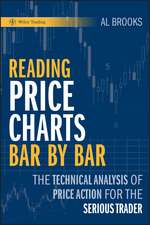Essentials of Corporate Finance ISE
Autor Stephen Ross, Randolph Westerfield, Bradford Jordanen Limba Engleză Paperback – 30 mar 2022
Essentials has three basic themes as a central focus: An Emphasis on Intuition: We always try to separate and explain the principles at work on a commonsense, intuitive level before launching into any specifics. A Unified Valuation Approach: We treat net present value (NPV) as the basic concept underlying corporate finance. A Managerial Focus: Students shouldn’t lose sight of the fact that financial management concerns management. We emphasize the role of the financial manager as decision-maker, and we stress the need for managerial input and judgment.
Preț: 437.99 lei
Preț vechi: 476.07 lei
-8% Nou
Puncte Express: 657
Preț estimativ în valută:
83.82€ • 91.02$ • 70.41£
83.82€ • 91.02$ • 70.41£
Carte disponibilă
Livrare economică 01-15 aprilie
Livrare express 15-21 martie pentru 52.27 lei
Preluare comenzi: 021 569.72.76
Specificații
ISBN-13: 9781265103514
ISBN-10: 1265103518
Pagini: 688
Dimensiuni: 203 x 252 x 28 mm
Greutate: 1.06 kg
Ediția:11
Editura: McGraw Hill Education
Colecția McGraw-Hill
Locul publicării:United States
ISBN-10: 1265103518
Pagini: 688
Dimensiuni: 203 x 252 x 28 mm
Greutate: 1.06 kg
Ediția:11
Editura: McGraw Hill Education
Colecția McGraw-Hill
Locul publicării:United States
Cuprins
Part One: Overview of Financial Management
Chapter 1: Introduction to Financial Management
Part Two: Understanding Financial Statements and Cash Flow
Chapter 2: Financial Statements, Taxes, and Cash Flow
Chapter 3: Working with Financial Statements
Part Three: Valuation of Future Cash Flows
Chapter 4: Introduction to Valuation: The Time Value of Money
Chapter 5: Discounted Cash Flow Valuation
Part Four: Valuing Stocks and Bonds
Chapter 6: Interest Rates and Bond Valuation
Chapter 7: Equity Markets and Stock Valuation
Part Five: Capital Budgeting
Chapter 8: Net Present Value and Other Investment Criteria
Chapter 9: Making Capital Investment Decisions
Part Six: Risk and Return
Chapter 10: Some Lessons from Capital Market History
Chapter 11: Risk and Return
Part Seven: Long-Term Financing
Chapter 12: Cost of Capital
Chapter 13: Leverage and Capital Structure
Chapter 14: Dividends and Dividend Policy
Chapter 15: Raising Capital
Part Eight: Short-Term Financial Management
Chapter 16: Short-Term Financial Planning
Chapter 17: Working Capital Management
Part Nine: Topics in Business Finance
Chapter 18: International Aspects of Financial Management
Appendices
Appendix A: Mathematical Tables
Appendix B: Key Equations
Appendix C: Answers to Selected End-of-Chapter Problems
Appendix D: Using the HP-10B and TI BA II Plus Financial Calculators
Chapter 1: Introduction to Financial Management
Part Two: Understanding Financial Statements and Cash Flow
Chapter 2: Financial Statements, Taxes, and Cash Flow
Chapter 3: Working with Financial Statements
Part Three: Valuation of Future Cash Flows
Chapter 4: Introduction to Valuation: The Time Value of Money
Chapter 5: Discounted Cash Flow Valuation
Part Four: Valuing Stocks and Bonds
Chapter 6: Interest Rates and Bond Valuation
Chapter 7: Equity Markets and Stock Valuation
Part Five: Capital Budgeting
Chapter 8: Net Present Value and Other Investment Criteria
Chapter 9: Making Capital Investment Decisions
Part Six: Risk and Return
Chapter 10: Some Lessons from Capital Market History
Chapter 11: Risk and Return
Part Seven: Long-Term Financing
Chapter 12: Cost of Capital
Chapter 13: Leverage and Capital Structure
Chapter 14: Dividends and Dividend Policy
Chapter 15: Raising Capital
Part Eight: Short-Term Financial Management
Chapter 16: Short-Term Financial Planning
Chapter 17: Working Capital Management
Part Nine: Topics in Business Finance
Chapter 18: International Aspects of Financial Management
Appendices
Appendix A: Mathematical Tables
Appendix B: Key Equations
Appendix C: Answers to Selected End-of-Chapter Problems
Appendix D: Using the HP-10B and TI BA II Plus Financial Calculators












